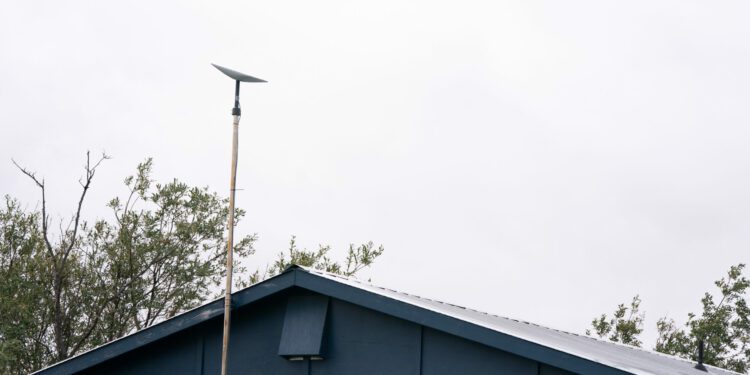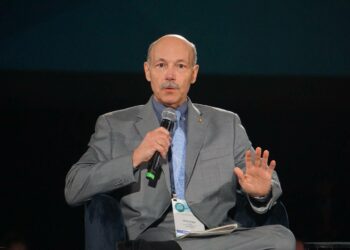A Starlink satellite internet receiver sits atop a pole in Bethel, Alaska. (MaryCait Dolan/KYUK)
The availability of high-speed internet from Starlink satellites has, by most accounts, been revolutionary in rural parts of Alaska.
Elders in villages can have face-to-face conversations with their grandkids living far away. The owners of broken-down snowmachines are able to watch videos showing how to fix them. A search-and-rescue crew even used Starlink to see social media posts that helped them find teenagers lost in a snowstorm.
And as Starlink continues to gain users, it’s forced traditional telecommunications companies, who’ve raked in hundreds of millions of dollars in federal subsidies, to compete.
Reporter Jenna Kunze wrote about Alaska’s Starlink revolution recently for the Anchorage Daily News. Kunze says the shift in many far-flung communities — where the ubiquitous, white, shoe-box-size Starlink receivers are sitting outside more and more homes — has been profound.
Listen:
[Sign up for Alaska Public Media’s daily newsletter to get our top stories delivered to your inbox.]
This interview has been lightly edited for length and clarity.
Jenna Kunze: So, from what I heard from folks on the internet and off the internet that — funny enough, were able to communicate with me because of this very product, Starlink — they’re able to do so much, from attending school online and taking classes, to being able to search Google for the first time. One woman had never used a search engine under her own roof before. One gentleman, Earl Atchak in Chevak, Alaska, uses it for his search-and-rescue crew and has been able to successfully locate missing people using Snapchat, to locate missing girls that had gone missing when they were coming to or from a basketball tournament in the winter during a blizzard. Another major thing that I heard from everyone that had these other facets of how they use it was communication with their family. You know, they’re able to Facetime and be close to people that don’t otherwise still live in the village or live in their small towns on a regular basis, and in a way that they can’t imagine their lives without it anymore.
Casey Grove: Yeah. Kind of like the rest of us, using it for all kinds of things, like looking up YouTube videos of how to fix your snow machine and whatever.
JK: Yes, exactly. The woman who just learned how to use Google for the first time was looking up knitting patterns to use, and also looking up how to use the pallets that are out the road to make her own smokehouse.
CG: Yeah, totally. So how did this all happen? That’s a big question. But you’ve got satellites, that part I think people understand, that you can get internet from satellites. But there were traditional, you know, what do you call them, terrestrial telecommunications companies before. So how did Starlink come in and, I guess you would say, “disrupt” that?
JK: The market. So it took someone that was able to self-fund this project, like the richest man in the world, Elon Musk, to be able to deploy these independent, low-Earth-orbit satellites and sell them at a market rate that is faster internet for a lesser price. You know, there’s 32 telecommunication carriers in the state of Alaska, but the big ones, like we know, like GCI, their product is, has remained, a lot less competitive.
And part of that is because these eligible telecommunication companies receive large amounts of federal dollars in subsidies to provide internet to like hospitals and schools, but also to homes. And the definition of what it takes to be an eligible communication company means you have to also provide voice service, so smaller companies don’t have access to that funding. Shawn Williams from Pacific Dataport calls it like a “David and Goliath” scenario, like it’s an impossible situation to go up against such a large sum of money to deploy internet in these small places. So that’s why it took an entrepreneur that was able to self-fund the project, and Starlink didn’t even become profitable to Elon Musk until last year.
CG: So those subsidies, I mean, Starlink isn’t getting those now. And like you said, if you’re not providing just sort of phone call service, voice service, you aren’t eligible for those subsidies. But are people trying to change that?
JK: There are people trying to change it, Pacific Dataport’s Shawn Williams being one of them, and a group called the Alaska Broadband Advocates, which is a coalition of 13 tribal advocates, are asking for broader access to government subsidies. So they recently, in May, went to Congress, to the Federal Communication Commission, to petition for this change and ask for a more lenient definition of what a eligible telecommunication carrier can mean.
CG: You mentioned that those flagship telecoms are now in a position of having to compete with Starlink. What did they tell you about that? I mean, things that they’re trying to do to be able to compete?
JK: Yeah, that’s a good question. I spoke with GCI, as the lone giant telecommunication provider for this story, and they say that they have been thinking about this for a while, before Starlink was even on the ground, of how to better provide internet access to their more remote locations. And they have several projects going, I think, too, that they’re building out. And you know, their main rallying cry, it seems, is also that their fiber — so providing, like, infrastructure in the ground — is better than satellite service. But that remains to be seen, as well as if that’s true and why that might be true.
CG: So I guess, as GCI and others maybe look to compete with Starlink, you wrote in your story, meantime, Starlink just continues to gain users, right? Is there any sense, I guess, either from the Facebook page or from Starlink itself, how many people have have logged on or, you know, bought into Starlink?
JK: That was a number that was hard to get, because it’s proprietary information on all ends. So Starlink itself, the organization, never, responded to a request for comment. And GCI says that’s proprietary information of how many clients they’ve lost. I was able to look at their — I didn’t get into this in the article — but tried to look at their year end budget statements to see, because they write the amount of userships, and it’s confusing. You have to extrapolate the data, and it’s not exact numbers, which is why I didn’t include it.
But GCI said themselves that they’ve seen a significant change in usership. And then colloquially, I’ve heard, you know that these folks in towns like Utqiagvik and in Chevak as well, used to go around, like some of the first people that had the Starlink transformers on the roof — the flat white antennas that you see everywhere now in the village — used to go around town to see who else had Starlink. And now they go around town to see who doesn’t have Starlink. So you just can see, anecdotally, that it has taken over.
CG: Yeah, no doubt, yeah. I mean, I have to say, I happened to go out on the Iditarod this last year, and it had been a while since I’d been in some of those places. And it just is kind of amazing to see those little receivers everywhere when you’re walking around, just outside pretty much every cabin. It made me wonder, too — and I should say, I mean, it’s easy for me to say this in Anchorage, where you can access high-speed internet pretty easily, so with that disclaimer — but were there people that were worried about that, like that it would come in and not just disrupt telecommunications companies, but maybe disrupt, like, the way of life, or, you know, social life in those places?
JK: Yes, there was a lone person who was worried about that, you know. And even him, Earl Atchak, who’s featured prominently in this story, is the first to say, like, “This is just what we need now. We can’t live without it.” And he himself is copping to that, that he can’t live without it, but he has noticed the way that it’s affected his boys, young kids that don’t want to go out and hunt and fish, or, like, be out at fish camp for longer than three days, where they don’t have internet access. And he’s reluctant to get a Starlink transformer out there, because he doesn’t want to, you know, corrupt this experience that he grew up with that was very pure in one thing.
But then, you know, in the next breath, he says, like, “It’s the best thing that ever happened to us.” He says, “Thank you, Elon Musk.” “Uncle Elon,” he calls him. And so yes, that is something that I think also, it remains to be seen, right? It’s only been two years in, to see the effects of it, but it will be interesting to see how it plays out. And also some folks, some older folks in the village, have compared it to when TV first came, you know, that that was like the new hot thing, and it changed the structure of the family a little bit and how they spent time together, but ultimately, it was how they learned their news, and it kept them connected to the rest of the world in a way that they weren’t previously.
CG: Yeah. And hopefully they’ll still listen to their radios, you know?
JK: Yeah!
CG: And, I mean, I guess, too, with Earl, it’s like the kids were still going hunting, right?
JK: Right, they were just complaining about missing their cell phone, and he, too, was like, “Damn, I also miss my phone.”

Casey Grove is host of Alaska News Nightly, a general assignment reporter and an editor at Alaska Public Media. Reach him [email protected]. Read more about Caseyhere.
Source link : http://www.bing.com/news/apiclick.aspx?ref=FexRss&aid=&tid=66cb7916ceb544b1afe3303cb84c7931&url=https%3A%2F%2Falaskapublic.org%2F2024%2F08%2F23%2Fin-rural-alaskas-starlink-revolution-new-opportunities-abound-and-flagship-telecoms-see-cause-for-competition%2F&c=13814703931518755601&mkt=en-us
Author :
Publish date : 2024-08-23 12:57:00
Copyright for syndicated content belongs to the linked Source.







